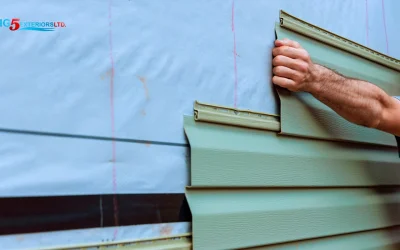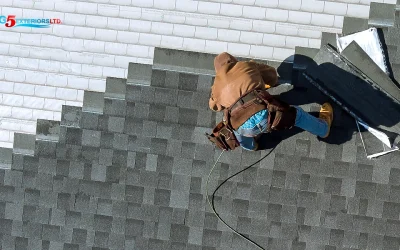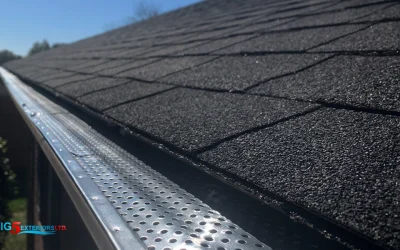Summary:
- Water can cause damage to a home’s foundation, even if it’s not moving quickly
- Water can collect in a variety of ways, including from poorly designed gutters
- Water around a foundation can cause hydrostatic pressure, leading to stress on the substructure of the building
- Water can create horizontal fissures in a foundation, causing the foundation to weaken
- Regular cleaning and maintenance of gutters, as well as other preventative measures, can help protect a home from water damage
Water is essential for life on our planet, but it can also be pretty destructive — just think about floods, hurricanes, and tidal waves. However, water doesn’t even need to take such dramatic forms for it to cause damage. In fact, one of the most subtle ways that water can exercise its considerable destructive power is by collecting around the foundation of your home.
That might not sound particularly dramatic. After all, those examples we just listed all involved water moving at incredibly high speeds — so how devastating could still water possibly be?
Pretty devastating, as it turns out — but let’s take a closer look at why. Join us as we go deep inside the foundation of your home to show you how water that builds up there over time can put stress on the building where you live.
Then, learn how simple equipment like your eavestrough can help prevent such damage, keeping the roof above your head stable and your long-term investment safe.
Check out the infographic below, or skip below to keep on reading.

What Does Water Do to Buildings?
Water can find its way to the base of your foundation in numerous ways. Sometimes it simply builds up in the loose, rich soil around your home. In other cases, it might filter down from flower beds near the walls, flow naturally from bedrock in the area, or leak out from broken plumbing infrastructure beneath your building. In many cases though, water simply ends up pooling around your foundation due to poorly designed or maintained gutters that simply aren’t able to take it where it needs to go.
When water collects around your foundation, it causes damage in three primary ways:
- Water that has built up causes hydrostatic pressure — simply put, the more water there is around a surface, the more force its exerting on that surface. However, the amount of water around your foundation isn’t constant. Even when it’s not moving, it’s either collecting and evaporating. This causes the amount of pressure on your foundation to shift periodically, which basically pushes the foundation back and forth whenever there are changes in the environment directly around your home. Over time, this can put stress on the substructure of the building.
- It’s also important to note that the water collecting near your foundation won’t accumulate evenly around the entire building. As a result, different parts of the foundation will be under different amounts of pressure, which can slowly tear the foundation apart by creating horizontal fissures.
- Once there are cracks in your foundation, nearby water will seep into them. This creates additional problems when the temperature changes, since water expands when it freezes. If water expands when it’s inside a crack, it forces the material around it even further apart, making the crack deeper and the foundation weaker.
Why is Water Management Important?
It’s easy to ignore a little water pooling around the foundation of your home, but it’s a bad idea to leave it alone for too long. Beyond structural damage, water left to gather around the foundation of a home can eventually crack the substructure to the point where it actually breaks through the walls and leaks into the basement.
Once that occurs, the costs you’ll incur as a building owner go way up, and will likely include things like mold removal in addition to foundation repairs.
What Role Does Your Eavestrough & Siding Play in Water Management?
Your eavestrough and siding are critical parts of your building’s ability to divert rainwater away from places where it could gather and pose a danger to your foundation.
Eavestroughs carry water to safe distances, while siding can offer partial protection from water that does find its way to your foundation.
However, it’s vital for building owners to understand that siding alone won’t be enough to completely prevent water damage to your foundation. Siding is meant to help resist moisture and rain but it won’t turn your home into a submarine; even carefully layered arrangements of sheeting, flashing, wrap, caulking, siding, and trim will eventually yield to water if surrounded by enough of it over time.
By cleaning your gutters regularly, repairing cracks, and removing blockages, you can prevent leaks and overflows and ensure that your siding is only dealing with the amount of water it is designed to handle effectively.
What Steps Can You Take to Protect Your Home from Water Damage?
As important as it is, regular gutter cleaning and maintenance is just one of the many ways in which you can prevent water damage to your foundation. Make sure you support the work you’re doing with your eavestroughs and siding with the following strategies:
- Position downspouts to release water at least 5-10 feet away from your house
- Replace any missing shingles on the roof of your building
- Landscape your yard so that water flows away from the foundation instead of towards it
- Make sure the dirt around your foundation doesn’t get too dry (dry soil expands dramatically when it rains, and puts greater pressure on nearby structures)
Conclusion
Water damage is common, but it doesn’t have to be inevitable. The more steps you take to keep water away from your foundation in large amounts, the less likely you’ll be to face the consequences. Remember: your eavestroughs and siding are critical lines of defense against water damage. Take good care of them and make sure to support them by maintaining the rest of your property responsibly. Feel free to contact our team with any questions. Our experienced team will be happy to assist you!






